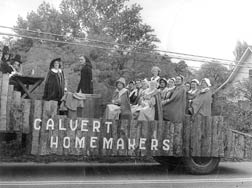
|
Searching out Women’s Achievements The lure and lore of local history exert a mighty pull on Grace Mary Brady. At the Calvert County Fair this week, she’s hoping to pull you, too, into the fair’s first exhibit dedicated to women’s achievements.
From the start of the Folklife project, Brady’s skill at talking and her familiarity with the Bay and its people were her greatest assets. “Some on the team were good with the technology, but they were unsuccessful in getting people to talk to them,” she says. “Most of the others didn’t even know what a waterman is. They didn’t know what a crab is. They didn’t know how to get a suspicious waterman to sign a release and talk on tape to some ‘foreigner.’ “I’d just say, ‘Aren’t you related to so-and-so? I knew his brothers so-and-so when they came over to the Western Shore to earn some money.” Being willing and able to talk to people and ask questions is the first skill in documenting living history. But there’s more to it, Brady learned. How to record tapes of archival quality was one lesson. Researchers use the highest quality recording equipment and beware of background noises. A refrigerator or water conditioner running in the next room or a diesel engine in the boatyard can ruin a tape. How to ask questions that will draw out your subject was another lesson. What brought you (or your family) to the area? she’d ask. Or Tell me about your business. How long have you been at it? What is the busiest time of year? What do you see for the future? Listen and learn was a third lesson. Whether interviews were at dining room tables or out in the boatyards, religion was a common theme. “Over and over people said, ‘God will provide. Nobody’s ever gone hungry,’ Brady recounts. On the Western Shore, she’s found values to be different. “I’ve always found the attitude that if there’s something wrong, what can I do? Here it’s man against nature,” she says. The Eastern Shore water community is also resilient, Brady found. “They adapt to the times. They’ve faced many economic challenges — like the loss of the seafood processing plant — by turning old Victorian homes into bed and breakfast, ice cream shop or antiques stores. Or they’ll convert the crab boat into a passenger ferry and charter boat. They are masters at turning things to another use.” On the technical side, the Smithsonian taught its folklife historians to put their trust in proven technology. Brady learned to Digital cameras and photos saved on CDs are not acceptable for they have not yet stood the test of time. Brady learned to use black and white film with a 35mm camera. As they posed, the old-timers told Brady “It’s not like it used to be. New people are changing everything.” The men, that is. “ It’s not the women who miss the past,” she says. Interviews and photography inevitably turn to the pleasurable topic of “food ways.” Crisfielders serve crabs and pork barbecue, but they’re also famous for seven-layer cake. Or maybe it’s nine-layer or 11-layer. The Folklife team tracked down and sampled all three sizes but were unable to authenticate a single official number. No matter how tall, the cake had some consistencies: many short layers of chocolate, banana or some other cake each with its slather of icing. Each piece, up to 12-inches tall, served flat on its own platter. All delicious. Especially the banana, according to Brady. But those are stories for next year. The team’s findings will be part of the 2004 Smithsonian Folklife Festival on the Mall in Washington, D.C., with the theme of Mid-Atlantic Maritime Communities in Transition. Over a million people typically visit the indoor and outdoor exhibits set up as a living community.
|
© COPYRIGHT 2003 by New Bay Enterprises, Inc. All rights reserved.
Last updated September 25, 2003 @ 12:57am

